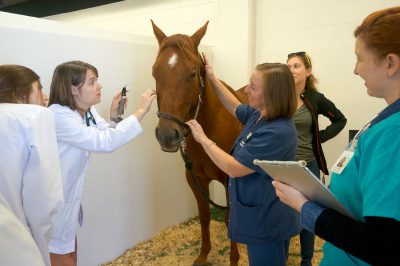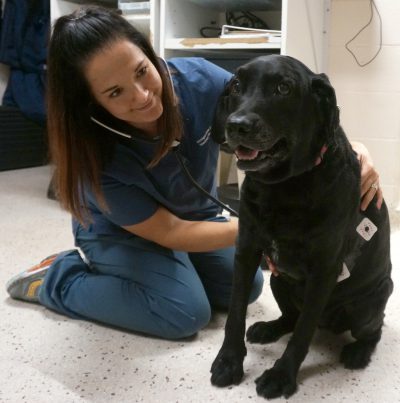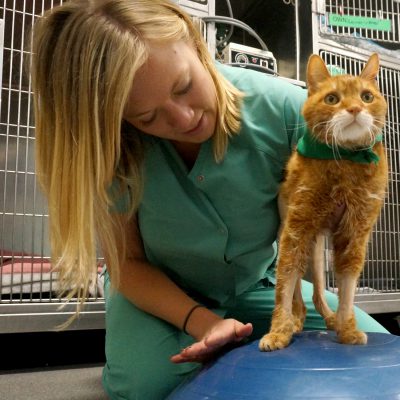
Editor's Note: In Spring 2020, the Veterinary Technology Program’s name changed to the Veterinary Nursing Program.
Licensed veterinary technicians (LVTs) are the backbones of veterinary teams everywhere, whether they work in general practice, specialty services, research, industry, or government. The MSU Veterinary Medical Center has more than 15 specialty services for large and small animals, and most of these teams include designated LVTs who do jobs similar to those of nurses in human medicine.
“That’s really what we are,” said Donna Averill, LVT and veterinary technician specialist for the Ophthalmology Service. “We are veterinary nurses—we are trained to work with many species of animals, we’re an integral part of client communication, and we can do anything for animals that human medicine nurses do for their patients.”
Averill has worked in general, emergency, and specialty practices. She assists veterinary students with ocular examinations on small animals, horses, food animals, and wildlife. Averill also teaches veterinary technology students and oversees communication with clients and referring veterinarians.

“Under Michigan law, the four things licensed veterinary technicians can’t do are diagnose, prognose, write prescriptions, or perform surgeries,” said Averill. “Beyond that, we are fully trained to meet patients’ needs.”
At MSU, each LVT supports their team by providing quality care and helping facilitate communication for patients and clients using the skills they learn during a rigorous training program. In Michigan, LVTs must pass state and national certifications before obtaining their license. Dyan Seehase, LVT, said this process has provided the skills she needs to support the Cardiology Service.
“It is important for the veterinarian in charge to have trust and confidence in the skills and judgment of the technicians they are responsible for,” said Seehase. “We share the responsibilities of patient safety and client satisfaction as a team.”
Patient advocacy is one of the most important parts of working in the veterinary field. Becky Rathbun, LVT, works in MSU’s Dr. Elwood and Linda Collins Rehab Center where she facilitates all kinds of treatments, such as hydrotherapy, laser treatment, massage, exercises, and mobility assistance. She works with geriatric patients, animals with mobility problems, and patients recovering from surgery. In order to provide the best care for each, it’s important that she knows how to advocate for every patient based on their individual needs.

“I have always felt that the most important job I have is to be my patients' advocate,” said Rathbun. “Animals can't speak to us, so we need to speak for them and make sure we are doing what is in their best interest. I take that responsibility very seriously, and I treat my patients as if they were my own pets.”
Besides advocacy and specialized skills, Averill, Rathbun, and Seehase also rely on their general skills—taking histories, administering medications, phlebotomy, surgical prep and assistance, injections, physical exams, and more.
“The basic skills of a well-trained licensed veterinary technician are universal,” Averill said. “Each new role you take on requires learning advanced skills in that area, continuing to increase your knowledge base through continuing education, and perfecting the new skills you have learned.”
All those skills and responsibilities add up to a busy day at the clinic—but Seehase said it’s worth it.
“It’s a lot of work, but it’s a rewarding career,” said Seehase. “We love what we do and we make an important difference in our patients’ lives.”
To learn more about the careers of licensed veterinary technicians, visit the National Association of Veterinary Technicians in America.
